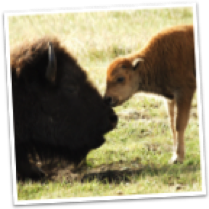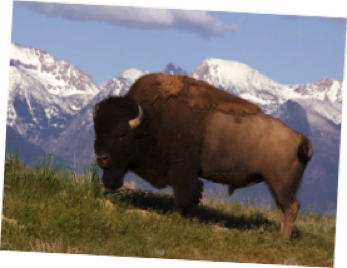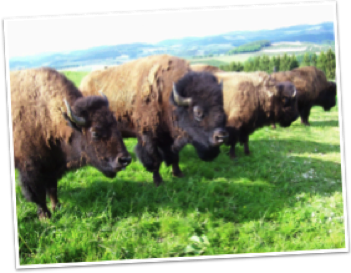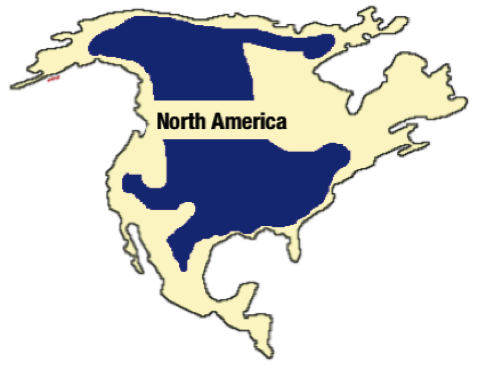





Fast Facts




Name: American Bison
Scientific: Bison bison
Family: Bovidae
Relatives: Wisent, Water Buffalo, Cape Buffalo
Environment: Prairie, Plains
Origin: North America
Life-span: 25 years
Size: 1,800 - 2,200 lbs
Bison are the largest and heaviest mammals in North America. Though they are a formidably large animal, Bison are agile. They can run nearly 40 mph, and can jump over 6 feet high..


Bison have historically been a symbol of the American West. It is estimated that over 60 million Bison roamed from Canada to Mexico before European settlers began the westward expansion.
Snapshot
1. Yellowstone has the oldest bison herd
2. Yellowstone has the largest bison herd
3. Bison can jump 6 feet vertically

Bison are commonly called buffalo, but are only distantly related to the water buffalo and cape buffalo.
About Me
A fully grown Bison bull stands 6 feet tall at the top of their shoulder, and weighs about 2,200 pounds. A bison cow is only slightly smaller, weighing around 1,000 pounds. Bulls are most distinguishable from females by their large heads and pronounced mane around their head and neck. Bison grow a thick coat for the winter, and their inner coat is shed annually in the Spring. The bison’s dense two-layered coat allows them to survive in the extreme temperature ranges of the Great Plains. The main outer layer of the bison’s coat consists of coarse guard hairs. These hairs help to shed rain and snow preventing accumulation that, with long term exposure, could lead to hypothermia. The inner layer of hair is a “down” undercoat. It is made of fine, soft, fibers that keep the bison warm by protecting their body from extreme cold temperatures. It also insulates their body to keep heat from escaping.
History
Prior to 1800, bison were very common all over the Great Plains of North America. American Indian plains tribes used the bison as an integral part of their daily lives, and depended on them for their survival for hundreds of years. The tribes utilized the all parts of the bison, leaving almost nothing to waste. The meat of the bison was eaten, as were the organs and the offal. Their hide including the hair was made into blankets, outerwear, clothing, shelters, and other leather goods. Their bones, hooves, organs, and tails served household functions. Individual tribes used the parts of the bison and often the animal as a whole as part of their ceremonies, spiritual traditions, and symbolism.
In the 19th century, bison were hunted to near extinction by settlers for food and sport. Eventually some European settlers began to kill bison and leave the whole carcasses as a way to control the plains tribes by eliminating their greatest resource. By the 1890s, there were only around 300 bison remaining on the Great Plains. Though there are no longer wild American Bison, their numbers have rebounded through conservation efforts and commercial meat producers. Now there are an estimated 500,000 animals in captivity, found in all 50 states, every Canadian province, and even countries overseas.
Economics
Starting in the 1960s, people began to raise bison for commercial meat production on both privately owned ranches and publicly owned land in America’s state parks. The bison meat movement did not truly catch momentum until the 1980s as more producers moved into the market, making it more accessible to the consumer. Over the last 20 years, the price of live bison breeding stock and drought conditions caused the bison market to dramatically fluctuate. In the late 1990s the cost of live bison become so high, ranchers were unable to purchase replacement stock. At the same time, the meat market began to flood with lower quality meat cuts. This eventually led to a market decline, and subsequently the price of live animals fell dramatically. In the early 2000s however, the industry began to rebound as consumers began looking for alternatives to traditional meat sources.
Meat
Bison meat is similar to beef though it is said to have a sweeter, richer flavor. Prior to cooking it is a deeper red in color and contains no marbling, or fat within the meat muscle. Bison meat is considered lean and contains less fat and fewer calories than beef. Bison meat, like beef, is available in many cuts including loins, steaks, roasts, and ground. Unlike beef however, experts recommend cooking bison meat at a lower heat, as it takes less time to cook to the desired degree.



